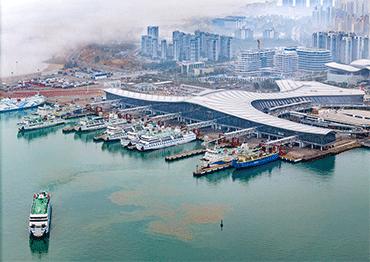Marked by frequent large gales, huge waves and volcanic and plate tectonic activity, the Qiongzhou Strait poses insurmountable challenges to construction given current technology, experts said.
According to Wu Shicun, president of the National Institute for South China Sea Studies in Hainan, issues such as high water pressure, corrosion and the unresolved complexities of ventilation systems in long-distance sea tunnels have impeded the development of cross-strait infrastructure.
Building a bridge over the Qiongzhou Strait would pose more challenges than construction of the Hong KongZhuhai-Macao Bridge, which took multiple technological breakthroughs to complete, the bridge’s chief engineer Su Quanke said at a 2018 press conference.
Factoring in the many trenches, thick layers of marine sediment and the harsh environment, the Qiongzhou Strait is not suited for cross-sea links, Su said. However, he stressed that with continued technological progress in engineering, such structures could be possible in the future.
But even with the right technology, cost is another big concern.
“The investment is likely to be substantial given the submarine crust ruptures, ridges and multi-layered soft sediment,” Li Shijie, president of the Institute of Human Resource Development of Hainan Free Trade Port, told NewsChina, adding that an undersea tunnel would be equally unaffordable for the province.
First included in the central government’s agenda in 1974, the Qiongzhou Strait Crossing Project is currently projected to cost over 200 billion yuan (US$27.78b). Hainan’s GDP reached 755 billion yuan (US$105b) in 2023, with a reported general public budget projects revenue of nearly 90 billion yuan (US$12.5b). The cost is not only prohibitive for Hainan, but also for Guangdong, one of China’s most developed provinces in terms of GDP ranking.
“It is not worth building a cross-strait link simply to ease traffic during Spring Festival. After all, it is just a periodic problem which happened to peak at this time,” said Ge Yaojun, a bridge engineering scholar at Tongji University in Shanghai.
Other national projects like bridges, viaducts and tunnels are a higher priority, Ge said.
“As a busy waterway, long-term construction on the Qiongzhou Strait will definitely affect sea traffic, causing immeasurable pressure on the regional economy and strategic development,” Li said.
Increasing traffic to and from Hainan creates challenges for law enforcement and environmental protection efforts. Included in its plans for Hainan Free Trade Port released in June 2020, the central government announced independent customs operations throughout the island would start by 2025.
“As an island, Hainan will be under enormous pressure to fight smuggling if any cross-strait bridge or tunnel is opened without curbing traffic flows,” Li said, adding that installing coastal checkpoints would greatly reduce these risks.
According to Wu with the National Institute for South China Sea Studies, increased capacity for travelers and vehicles would further stress the local environment and infrastructure.
Hotels in Sanya hit an unprecedented 90-percent occupancy rate during this year’s Spring Festival. Coupled with the city’s 10.3 million permanent residents, according to data from 2022, surges in tourist traffic from a proposed crossing could potentially overload local infrastructure capacity.

 Old Version
Old Version


